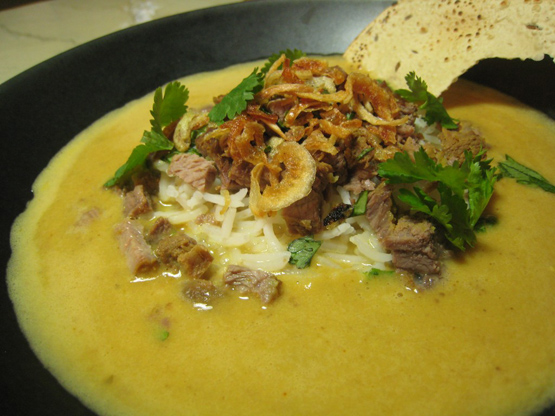 Mulligatawny soup is perhaps one of the most well known Anglo-Indian dishes that came out of the Raj, the period of the British rule of India. Jennifer Brennan’s culinary memoir, Curries and Bugles: A Cookbook of the British Raj, is a solid account of what the cultural and culinary life was like for the British living in India from the late 19th century up to 1947, the time of Indian Independence. In it she describes how mulligatawny soup is a derivative of South Indian rasam, a watery broth of lentils, ground spices, made slightly sour with tamarind. Since the soup course is not really part of an Indian meal it was most likely a British memsahib (“housewife”), who wanted to offer a unique soup to their guests, and asked her cook to come up with a solution. It really is that first South Indian cook, and not the memsahib, who should be credited with the innovative idea of merging his staple daily rasam with vegetables and meat to create a satisfying soup.
Mulligatawny soup is perhaps one of the most well known Anglo-Indian dishes that came out of the Raj, the period of the British rule of India. Jennifer Brennan’s culinary memoir, Curries and Bugles: A Cookbook of the British Raj, is a solid account of what the cultural and culinary life was like for the British living in India from the late 19th century up to 1947, the time of Indian Independence. In it she describes how mulligatawny soup is a derivative of South Indian rasam, a watery broth of lentils, ground spices, made slightly sour with tamarind. Since the soup course is not really part of an Indian meal it was most likely a British memsahib (“housewife”), who wanted to offer a unique soup to their guests, and asked her cook to come up with a solution. It really is that first South Indian cook, and not the memsahib, who should be credited with the innovative idea of merging his staple daily rasam with vegetables and meat to create a satisfying soup.
As the weather turns colder this is a great soup to have as a light meal. This recipe uses local lamb, from La Ferme Albe, but chicken can also be substituted. Including diced and blanched potatoes, carrots or turnips as a garnish can make this a more substantial soup. With only a couple of omissions and additions a vegetarian version is quick and easy to make (see end of recipe).
- 2 tbsp vegetable oil or ghee
- 1 pound (1/2 kg.) cubed lamb leg or shoulder; or substitute with chicken thighs on bone
- 1 medium sized onion, finely chopped
- 16-20 curry leaves
- 1 tbsp garlic, finely chopped
- 1 tbsp ginger, finely chopped
- 1 teaspoon cumin seeds, roasted and ground
- 1 teaspoon coriander seeds, roasted and ground
- ½ teaspoon ground turmeric
- ½ teaspoon paprika
- ½ teaspoon ground cayenne (for mild) or ¾-1 tsp for a kick!
- 1 bay leaf
- 2 plum tomatoes, finely chopped
- ¾ cup masoor dal (split red lentils)
- 6 cups chicken stock, vegetable stock or water
- 1 (400ml) can of coconut milk
- 4-6 tbsp tamarind water or to taste
- Salt and pepper
- Coriander leaves, for garnish
- Fried onions, for garnish (optional)
Replace lamb with bite sized pieces of mushrooms.
Replace chicken stock with vegetable stock or water.
Reduce cooking/simmering time to 20 minutes.
Remember to remove and set aside mushrooms before pureeing soup.
Other cooked vegetables (ie boiled cauliflower, fried eggplant or stir fried greens) or pulses (such as cooked chickpeas/ or other pulses) can be added at end as a further garnish.
NOTE: This was originally published on my blog India On My Plate on November 15, 2011
